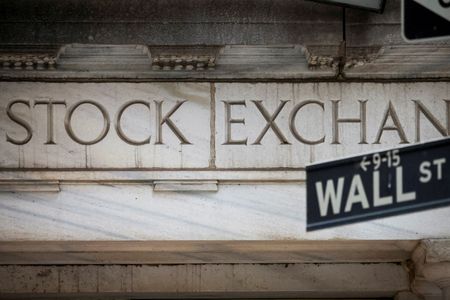
By David French and Ankika Biswas
(Reuters) – Wall Street benchmarks tumbled again on Tuesday, with the S&P 500 on course for a fourth straight decline, as uncertainty around the direction of Federal Reserve rate hikes and further talk of a looming recession weighed on skittish investors.
Among the biggest drags on the S&P was Meta Platforms Inc, which slid 6.6% following reports that European Union regulators have ruled the company should not require users to agree to personalized ads based on their digital activity.
However, all of the 11 major S&P sectors were lower in early afternoon trading, with energy and communications services joining the technology sector as leading laggards. Defensive sectors such as utilities, often preferred during times of economic uncertainty, fared better.
Future economic growth prospects were in focus on Tuesday following comments from financial titans pointing toward uncertain times ahead.
Bank of America Corp’s chief executive predicted three quarters of mild negative growth next year, while JPMorgan Chase and Co’s CEO Jamie Dimon said inflation will erode consumer spending power and that a mild to more pronounced recession was likely ahead.
Their comments came on the heels of recent views from BlackRock and others that believe the U.S. Federal Reserve’s aggressive monetary tightening to combat stubbornly high price rises could induce an economic downturn in 2023.
“There’s a general expectation of a contraction in the economy in the first couple of quarters and it’s going to have an impact on earnings, which is what investors are focused on,” said Hugh Johnson, chief economist of Hugh Johnson Economics in Albany, New York.
Banks are among the most sensitive stocks to an economic downturn, as they potentially face negative effects from bad loans or slowing loan growth. The S&P banks index was down 2.6%, with Bank of America leading declines with a 5.6% drop.
Fears about economic growth come amid a re-evaluation by traders of what path future interest rate hikes will take, following strong data on jobs and the services sector in recent days.
Money market bets are pointing to a 91% chance that the U.S. central bank might raise rates by 50 basis points at its Dec. 13-14 policy meeting, with rates expected to peak at 4.98% in May 2023, up from 4.92% estimated on Monday before service-sector data was released.
The S&P 500 rallied 13.8% in October and November on hopes of smaller rate hikes and better-than-expected earnings, although the expectation for slower rate hikes could be undermined by further data releases, including producer prices due out on Friday.
“If economic growth continues to be better than what people are expecting, there are chances that the Fed would have to continue to be hawkish,” said Rusty Vanneman, chief investment strategist at Orion Advisor Solutions.
By 2:21 p.m. ET (1921 GMT), the Dow Jones Industrial Average fell 472.5 points, or 1.39%, to 33,474.6, the S&P 500 lost 71.19 points, or 1.78%, to 3,927.65 and the Nasdaq Composite dropped 249.91 points, or 2.22%, to 10,990.03.
Jitters on the direction of global growth have also weighed on oil prices, with U.S. crude slipping to levels last seen in January, before Russia’s invasion of Ukraine disrupted supply markets. The energy sector fell 2.6% on Tuesday.
Elsewhere, Mirati Therapeutics Inc slumped 21.1% – on course for its largest daily drop since March 2020 – after the company reported disappointing early trial data on its experimental cancer drug adagrasib.
Textron Inc climbed 4.9% after the U.S. Army awarded the contract for its next-generation helicopter to the company’s Bell unit.
(Reporting by Devik Jain, Ankika Biswas and Johann M Cherian in Bengaluru and David French in New York; Editing by Vinay Dwivedi, Shounak Dasgupta and Lisa Shumaker)

